Did you know that trees can absorb nearly 80% of their nutrients from the soil through their roots? Choosing the right fertilizer spikes can make a significant difference in your garden's health and growth. With so many options available, it's vital to find the best products that meet your specific needs. What are the top contenders that guarantee your trees thrive and flourish? Let's explore the five best tree fertilizer spikes that can elevate your gardening experience.
Jobes 01310 Fertilizer Spikes, Tree and Shrub, 9 Count (Pack of 2)
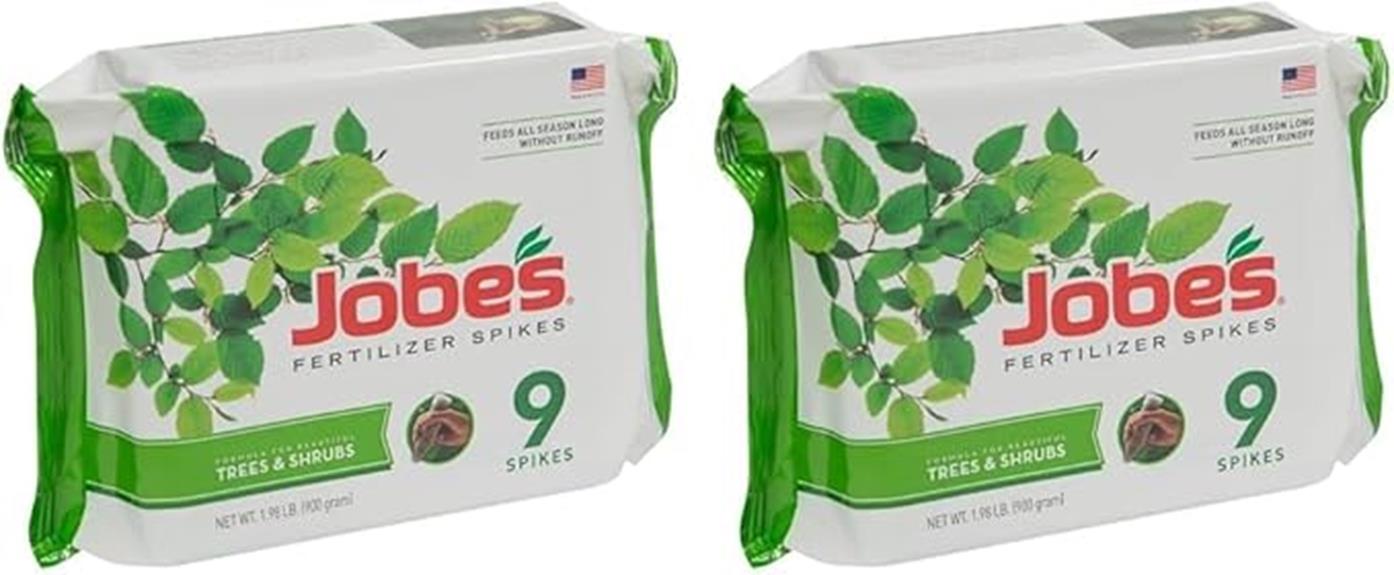
If you're looking for a hassle-free way to nourish your trees and shrubs, the Jobes 01310 Fertilizer Spikes are an excellent choice for both novice and experienced gardeners. These spikes are incredibly easy to use—just insert them around your plants' drip line, and you're set! Each spike releases nutrients slowly, ensuring your trees and shrubs get a steady supply over time. I love that there's no mess or runoff; the nutrients go right to the roots where they're needed most. With a customer rating of 4.6 stars from over 22,000 reviews, it's clear many gardeners, including myself, have seen great results. Overall, these spikes are a practical solution for promoting healthy growth throughout the season.
Best For: Gardeners looking for a convenient and effective way to nourish their trees and shrubs with minimal effort.
Pros:
- Easy Application: Simple insertion around the plant's drip line with no mixing or measuring required.
- Slow Release Formula: Provides continuous nourishment, promoting healthy growth throughout the season.
- No Mess: Direct delivery of nutrients to the roots minimizes waste and environmental impact.
Cons:
- Potential Species Sensitivity: Some users reported negative effects on specific trees, such as oak trees.
- Installation Challenges: Hard soil can make it difficult to insert spikes, leading to breakage.
- Mixed Results: Not all users experienced noticeable effects on certain plants.
Jobe's Fertilizer Spikes for Trees & Shrubs (15 Spikes, 12 Ounces)
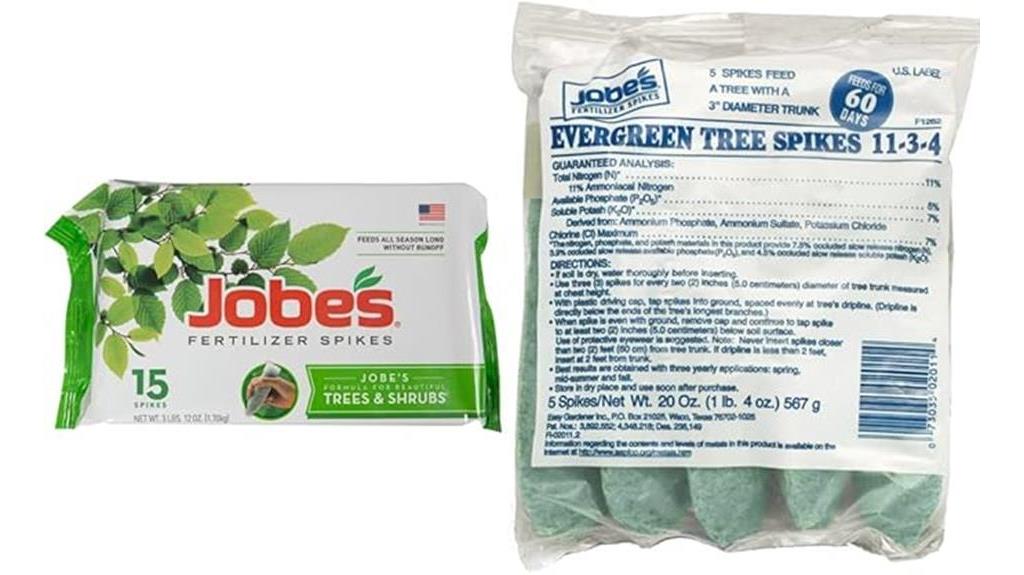
Jobe's Fertilizer Spikes for Trees & Shrubs are ideal for gardeners looking to nourish their deciduous trees and shrubs effortlessly. Each pack contains 15 pre-measured spikes, designed to deliver a continuous supply of nutrients directly to the roots, where they're needed most. I love the slow-release formula, which keeps my plants thriving all season long. The application process is straightforward; I simply insert the spikes around the tree's dripline in early spring or late fall. Plus, there's no mess or hazardous smells involved, making it a convenient choice for anyone wanting a safe and beautiful yard. With a solid customer rating of 4.6 out of 5 stars, these spikes are a reliable option for nurturing my garden.
Best For: Gardeners looking for an easy and effective way to nourish their deciduous trees and shrubs.
Pros:
- Slow-release formula ensures continuous nutrient supply throughout the growing season.
- Easy application with pre-measured spikes that can be inserted around the tree's dripline.
- No mess or hazardous smells, promoting a safe gardening experience.
Cons:
- May not be suitable for all types of trees and shrubs, particularly non-deciduous varieties.
- Limited quantity in each pack (15 spikes), which may not be enough for larger gardens.
- Requires specific application periods (early spring and late fall) for optimal results.
Jobes Organics Tree Spikes and Fertilizer for Fruit, Nut, Evergreen Trees
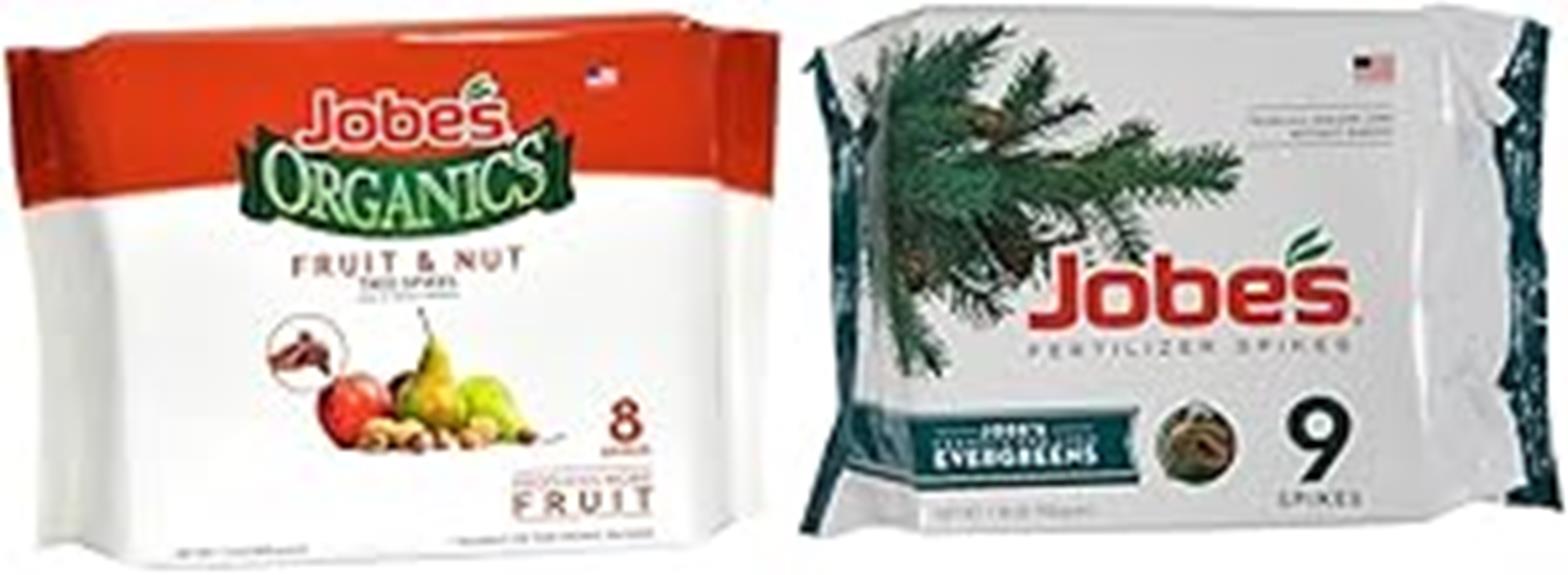
For those nurturing fruit, nut, and evergreen trees, Jobes Organics Tree Spikes offer a convenient and effective solution to promote robust growth and bountiful yields. These spikes come in packs tailored for different tree types, with options for both fruit and nut trees, as well as acid-loving evergreens. I love how the time-release formula nourishes the roots steadily throughout the season, ensuring that my trees get the nutrients they need without the mess of traditional fertilizers. By placing the spikes around each tree's dripline in early spring and late fall, I've noticed healthier trees and better yields. Plus, the organic ingredients support beneficial microbial activity, enhancing soil health over time. It's a simple, effective way to keep my garden thriving.
Best For: Gardeners looking to promote healthy growth and yields in fruit, nut, and evergreen trees with an easy-to-use organic fertilizer solution.
Pros:
- Time-release formula ensures continuous nutrient delivery for long-lasting tree health.
- Mess-free application prevents runoff and simplifies the fertilization process.
- Supports microbial activity in the soil, enhancing overall soil quality over time.
Cons:
- Limited to specific tree types, which may not suit all gardeners' needs.
- Requires proper placement around the dripline, which may require some effort and planning.
- The price point may be higher compared to traditional fertilizers.
Jobes Fertilizer Spikes for Trees and Shrubs (9 Count)
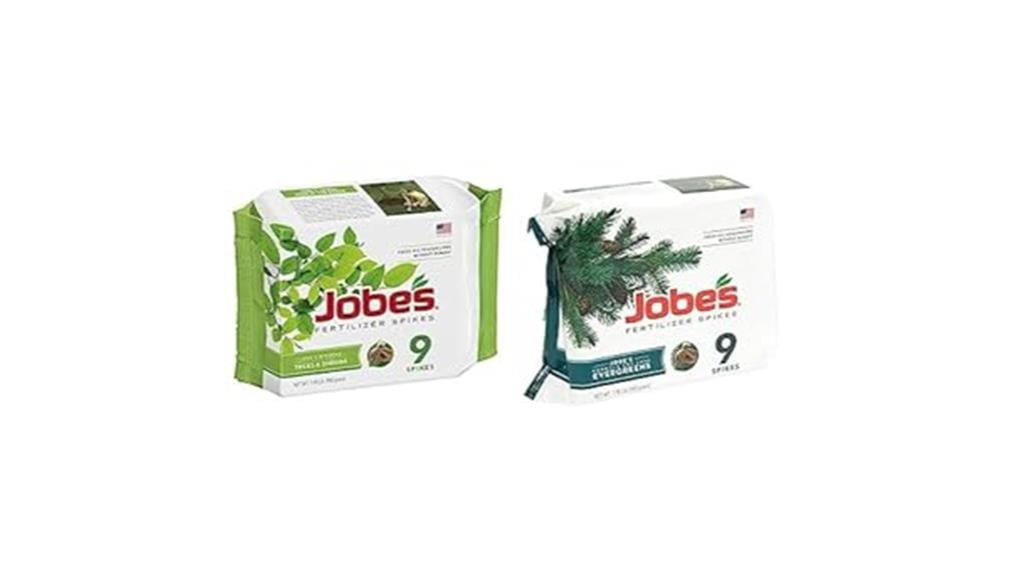
Designed specifically for trees and shrubs, Jobes Fertilizer Spikes (9 Count) are an excellent choice for gardeners looking to simplify their fertilization routine. I love how easy they are to use—just insert them around the plant's dripline, and you're set! The slow-release formula guarantees that nutrients are available throughout the growing season, maximizing plant health. I've seen significant improvements in my trees and shrubs, including better growth and more blooms. Plus, these spikes deliver nutrients right to the roots, minimizing waste and mess. While some users mention issues with broken spikes, I've found them effective and convenient overall. If you're after a straightforward fertilization solution, I highly recommend Jobes Fertilizer Spikes.
Best For: Gardeners looking for an easy and effective way to fertilize trees and shrubs.
Pros:
- Easy to apply by simply inserting around the plant's dripline.
- Slow-release formula provides nutrients throughout the growing season.
- Delivers nutrients directly to the roots, reducing waste and mess.
Cons:
- Some users report issues with broken spikes.
- May not be suitable for all plant species.
- Limited application periods (early spring and late fall) may not fit all gardening schedules.
Jobe's Plant Food Fertilizer Spikes for Indoor Flowering Houseplants (Pack of 2)
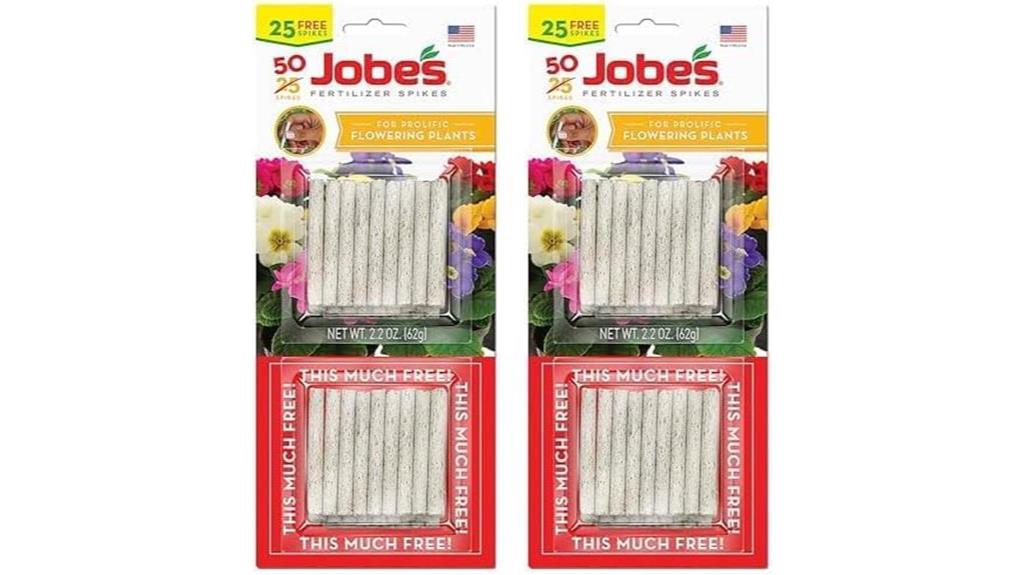
If you're looking for an effortless way to nourish your indoor flowering houseplants, Jobe's Plant Food Fertilizer Spikes are a fantastic option. These pre-measured spikes, packed with a balanced 10-10-4 NPK formula, guarantee vibrant blooms and lush foliage. Simply insert the spikes into the soil, and they'll release nutrients slowly over 60 days. I love how easy they are to use, especially if you're busy like me. With positive feedback from users about plant health and growth, I've seen my own plants thrive. While some debate their effectiveness compared to liquid fertilizers, I appreciate the convenience and cost-effectiveness. Jobe's spikes are definitely a go-to for indoor plant care that delivers results.
Best For: Busy individuals seeking an easy and efficient way to nourish their indoor flowering houseplants.
Pros:
- Convenient and easy to use, requiring no mixing or measuring.
- Slow-release formula provides nutrients over 60 days, promoting healthy growth.
- Positive user feedback on effectiveness for both indoor and outdoor plants.
Cons:
- Some users question the efficacy compared to liquid fertilizers.
- May require adjustment in quantity based on specific plant needs.
- Limited to indoor flowering houseplants, which may not suit all plant types.
Factors to Consider When Choosing Tree Fertilizer Spikes
When you're picking tree fertilizer spikes, you should consider several key factors. Think about the nutrient composition and how it matches your tree's needs, as well as how easy they are to apply. Don't forget to check the compatibility with your specific plant species and the environmental impact of your choice.
Nutrient Composition and Ratios
Choosing the right tree fertilizer spikes involves understanding their nutrient composition and ratios. Most spikes contain essential elements like nitrogen (N), phosphorus (P), and potassium (K), often presented in common ratios such as 10-10-4. A balanced ratio guarantees your trees get enough nutrients for root development, flowering, and overall growth. Nitrogen promotes lush foliage, phosphorus supports healthy roots and flowers, and potassium enhances disease resistance.
Opting for slow-release formulas is wise, as they gradually provide nutrients over time, reducing the risk of runoff and making sure your trees receive a steady supply throughout the growing season. Additionally, some fertilizer spikes may include secondary nutrients like calcium, magnesium, and sulfur, which are vital for overall plant health and metabolic functions.
It's important to take into account the specific nutrient needs of your trees, as different species may require specialized formulations to thrive. For instance, acid-loving varieties or those in nutrient-deficient soils might benefit from tailored spikes. By understanding these nutrient compositions and ratios, you can make informed choices that promote your trees' health and vibrancy.
Application Ease and Method
Understanding nutrient composition and ratios is only part of selecting the right tree fertilizer spikes; application ease and method also play a significant role. Most tree fertilizer spikes come with a simple insertion method, allowing you to place them around each plant's drip line without the hassle of mixing or measuring. This convenience means you can spend less time preparing and more time enjoying your garden.
For ideal results, apply these spikes during early spring and late fall, as this timing maximizes nutrient absorption when your trees are actively growing. The pre-measured nature of the spikes eliminates the risk of over-fertilization, guaranteeing your trees receive just the right amount of nutrients.
Many spikes use slow-release formulas, providing a continuous supply of essential nutrients throughout the growing season and promoting sustained tree health. Before application, verify the soil is soft; hard soil can lead to difficulties and even breakage of the spikes during insertion. By considering application ease and method, you'll set your trees up for thriving growth and health.
Plant Species Compatibility
Considering the unique nutrient needs of different tree species is important for selecting the right fertilizer spikes. Each tree type, whether deciduous, evergreen, or fruit-bearing, has specific requirements that can greatly impact its growth and health. For instance, if you're nurturing acid-loving species like magnolias or certain fruit trees, look for spikes formulated with higher levels of nutrients tailored to their needs.
Moreover, it's essential to assess the growth stage of your trees. Young trees often require different nutrients than mature ones, so targeted options are necessary for ideal development. A slow-release fertilizer spike can be particularly beneficial, as it provides a consistent supply of nutrients over time, which is crucial for actively growing roots.
Also, keep in mind that compatibility affects nutrient absorption. Some trees may thrive better with specific formulations designed to boost root growth and enhance microbial activity in the soil. By taking the time to match the fertilizer spikes to the species in your garden, you'll guarantee they receive the nutrition they need to flourish. This thoughtful approach will lead to healthier, more robust trees in your landscape.
Release Duration and Timing
The release duration and timing of tree fertilizer spikes play an essential role in the health and growth of your trees. Opting for slow-release formulas is advantageous, as they provide nutrients over an extended period, typically throughout the growing season. This guarantees that your trees and shrubs receive a steady supply of essential nutrients, allowing for peak growth.
Timing your application is just as important. Early spring and late fall are the best times to apply tree fertilizer spikes, aligning with the active growth periods of deciduous trees and shrubs. This timing maximizes nutrient absorption and supports healthy development.
When selecting fertilizer spikes, consider the specific needs of your tree species. Different types of trees may require varying nutrient release profiles, so it's significant to choose spikes tailored to your plants. Additionally, slow-release formulas minimize the risk of nutrient runoff and make sure that nutrients reach the root zone directly, enhancing efficiency.
Environmental Impact Considerations
When selecting tree fertilizer spikes, it's important to think about their environmental impact. Opting for spikes with a slow-release formula can greatly reduce nutrient runoff, which protects surrounding soil and water systems. This means you're not just feeding your trees; you're also safeguarding the environment.
Many fertilizer spikes are designed to deliver nutrients directly to the roots, minimizing wasteful runoff and promoting sustainable nutrient absorption. This targeted approach helps guarantee your trees thrive while being eco-conscious. If you're keen on supporting a healthy ecosystem, consider organic fertilizer spikes. They enhance microbial activity in the soil, contributing to long-term soil quality and overall ecosystem health.
Look for spikes that are formulated to prevent mess and hazards. This contributes to safer gardening practices, benefiting both your garden and the environment. Additionally, selecting spikes tailored for specific tree and shrub species ensures that nutrients are effectively used, reducing excess fertilizer application and its associated environmental consequences. By keeping these considerations in mind, you can make informed choices that nurture your trees and protect the planet.
Packaging and Quantity Options
Choosing the right packaging and quantity of tree fertilizer spikes is essential for effective application and cost efficiency. When selecting, consider the size of your garden and the number of trees or shrubs you're treating. Fertilizer spikes typically come in packs of 5, 9, or 15, allowing you to buy just what you need. If you have a larger garden or a landscaping project, bulk options with 160 spikes can save you money and reduce the frequency of purchases.
Additionally, pay attention to the weight and dimensions of the packs. A typical pack might weigh around 0.46 pounds, which can affect shipping and storage. Compact sizes, like 1 x 1.75 x 4.5 inches, are easier to handle and store, making them a practical choice.
Frequently Asked Questions
How Often Should I Apply Tree Fertilizer Spikes?
You should apply tree fertilizer spikes once or twice a year, typically in early spring and late fall. This timing guarantees your trees get the nutrients they need during their active growth phases. Make certain to follow the manufacturer's instructions for the specific product you're using, as different formulations may have varying application rates. Always monitor your trees' health and adjust the timing or frequency as needed for ideal growth and health.
Are Fertilizer Spikes Safe for Pets and Wildlife?
Wondering if fertilizer spikes are pet-friendly? You're not alone! Generally, most fertilizer spikes are safe for pets and wildlife, as long as you follow the instructions. However, some ingredients can be harmful if ingested in large amounts. To keep your furry friends safe, place the spikes in areas where they can't reach. Always check the label for any specific warnings, and it's best to keep an eye on your pets after application.
Can I Use Tree Spikes on Flowering Plants?
You can use tree spikes on flowering plants, but it's crucial to check the specific nutrient needs of your plants first. While these spikes provide essential nutrients, they're formulated mainly for trees. Over-fertilizing can harm your flowering plants, so consider using a product specifically designed for them. If you do decide to use tree spikes, monitor your plants closely for any signs of stress or nutrient imbalance.
What Is the Best Season to Use Fertilizer Spikes?
Think of your garden like a party; you want to invite the right guests at the right time. The best season to use fertilizer spikes is during the spring, right when trees emerge from dormancy. This timing guarantees your trees get a boost of nutrients as they start to grow. You can also apply them in early fall to help prepare your trees for winter. Just remember, it's all about timing for those vibrant blooms!
How Do I Know if My Trees Need Fertilization?
You can tell if your trees need fertilization by observing their growth and overall health. If you notice stunted growth, yellowing leaves, or fewer blooms, it might be time to give them some nutrients. Checking the soil can also help; if it's depleted or lacking essential minerals, your trees won't thrive. Additionally, consider the tree species and their specific needs, as some require more frequent fertilization than others.
Wrapping Up
Just like a gardener nurturing a sapling, choosing the right tree fertilizer spikes can help your trees flourish. Imagine each spike as a tiny wellspring, delivering life-giving nutrients directly to the roots, ensuring they grow strong and vibrant. By selecting the best options, you're not just feeding trees; you're cultivating a lush, green haven in your garden. So, plant those spikes with care, and watch your trees reach for the sky, bursting with health and beauty.
